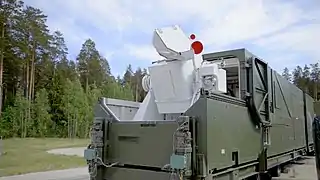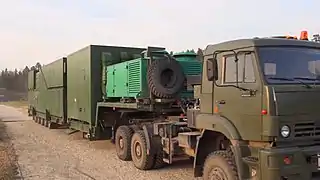Peresvet (laser weapon)
The Peresvet (Russian: Пересвет, named after Alexander Peresvet, also a wordplay, pere-svet means "over-light") is a Russian laser weapon. Most of the information about the complex remains secret; however, according to experts, it is supposed to perform the tasks of Air Defense and Missile defense.[2]
| Peresvet | |
|---|---|
 | |
| Type | Directed-energy weapon |
| Place of origin | Russian Federation |
| Service history | |
| In service | December 2019 - present |
| Used by | Russian Armed Forces |
| Production history | |
| Produced | Since 2017 |
| No. built | At least 5[1] |
| External video | |
|---|---|
The Peresvet is one of the six new Russian strategic weapons unveiled by Russian President Vladimir Putin on 1 March 2018.
History
The system was revealed for the first time by Russian President Vladimir Putin during his message to the Federal Assembly on 1 March 2018. The equipment of the Armed Forces of the Russian Federation with the complexes began in 2017. On 1 December 2018, the Peresvet laser complex took over experimental combat duty.[3] According to Valery Gerasimov, the Peresvet laser complexes have been on the combat duty since the beginning of December 2019. The complexes have been deployed with the road-mobile ICBM launchers with the task of covering their maneuvers.[4] According to Sergei Shoigu, as of 1 December 2019, Peresvet was deployed with five RVSN rocket divisions.[1]
Design
According to the military expert Igor Korotchenko, director of the Center for Analysis of the World Trade in Arms, the Peresvet combat laser can be successfully used against unmanned aerial vehicles. At the same time, its effectiveness directly depends on environmental conditions; in good weather, it works perfectly, but fog, rain, snow and other adverse weather events can interfere with the passage of the laser beam. The expert also added that such installations consume a lot of electricity, so using them as a portable tool is unlikely to succeed; but in the future they will be able to protect military bases and other locations from penetrations of UAVs into their territory.[5]
Gallery
 Marching configuration
Marching configuration Transition to combat configuration
Transition to combat configuration Combat configuration
Combat configuration
References
- "В России завершили развертывание установок "Пересвет", заявил Шойгу" (in Russian). RIA Novosti. 24 December 2019. Retrieved 24 December 2019.
- "Russian claims that new Peresvet combat laser system already in service - Defense Blog". 2018-07-18. Retrieved 2019-01-21.
- "На боевое дежурство заступили «Пересветы» — "Красная звезда"".
- "Начальник Генерального штаба Вооруженных Сил Российской Федерации генерал армии Валерий Герасимов встретился с представителями военно-дипломатического корпуса, аккредитованными в России" (in Russian). 18 December 2019. Retrieved 18 December 2019.
- Expert told about the shortcomings of the Peresvet combat laser // Mail-ru
External links
- The Ministry of Defense of the Russian Federation placed combat lasers in places of dislocation // NG, August 5, 2018
- Will Peresvet achieve the goal // NG, Dec 5, 2018
- Боевой лазерный комплекс "Пересвет" [Peresvet combat laser complex]. Ministry of Defence of the Russian Federation (in Russian).
- Hendrickx, Bart (June 15, 2020). "Peresvet: a Russian mobile laser system to dazzle enemy satellites". The Space Review. — An overview of Russian combat laser programs.